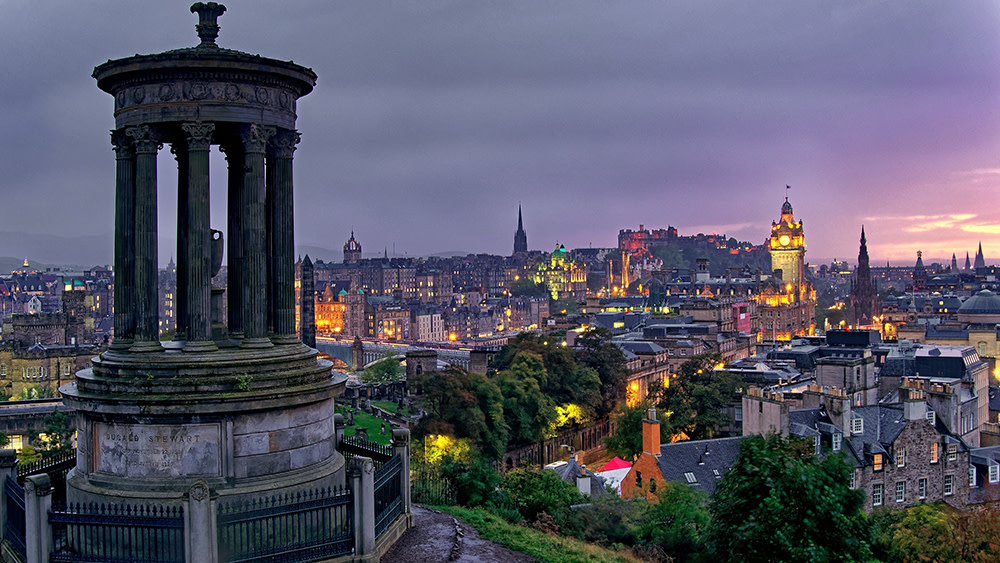With a looming medieval castle perched high atop an extinct volcano, Edinburgh (pronounced ED-in-bruh) may seem intimidating at first. But spend some time here and you’ll find a friendly city that knows how to have fun: Scotland’s capital invites people from all over the world to celebrate at its myriad festivals each year.
As for welcoming students, Edinburgh makes a great “home away from home” for international students: It’s ranked the 10th best student-friendly city in the world. The city’s population boasts 12% students and”39% of students at ranked universities in Edinburgh are international, providing a diverse and inclusive atmosphere,” according to a QS 2022 article.
The best way to feel good about going to a new destination is knowing what to expect when you get there. Edinburgh is considered one of the safest cities the United Kingdom, but learning where to go, how to get around, the food you might encounter, and more can help ease the concern about feeling out of place.
Our guide to studying abroad in Edinburgh gives a quick snapshot of what life is like for international students (like those attending Shorelight school Heriot-Watt University), and hopefully makes the transition to life in Scotland a little easier.
The Lay of the Land in Edinburgh
Take one look at the streets of Edinburgh, and it is easy to see why the city is accredited as a UNESCO World Heritage Site. The Old Town is made up of cobblestone walkways, winding alleys, and medieval architecture, while New Town features paved streets, modern-day houses, and boutique shops.
The city is divided into 13 unique neighborhoods, each offering a great reason to visit. The most famous (and the oldest) is the Royal Mile in Old Town, which runs from Edinburgh Castle to Holyroodhouse Palace, and includes a myriad of historically significant sites and attractions in between.
How to Get Around Edinburgh
With its relatively small size and centrally located attractions, Edinburgh can be traversed by foot. You may want to bring a pair of comfortable shoes though, because it can be quite hilly. If you get tired of walking, or are traveling further afield, there are other transportation options.
You can opt to hop on one of the 24-hour buses that stop frequently throughout the city center and travel to the outskirts of Edinburgh. The Edinburgh Trams is another option and offers 15 stops along its one route from York Place to Edinburgh Airport. For a more direct trip to where you are going, hail one of the city’s many black cabs or book a lift through a ride-share app.
What the Weather Is Like in Edinburgh
Edinburgh has a temperate maritime climate: Summers boast some sunny yet mild days (average high temperature reaches 65°F, 19°C), while winters can be chilly and damp (average high temperature reaches 45°F, 7°C). Rain can happen at a moment’s notice at any time of year, so it is always a good idea to have a rain jacket or umbrella handy.
Must-See Spots in Edinburgh
Whether you are interested in art, natural science, history, literature, animals, or music, there truly is something for everyone in Edinburgh. Some of the city’s most popular attractions include, but are certainly not limited to:
Edinburgh Castle: Serving as a royal residence, military garrison, prison, and fortress, Edinburgh Castle is one of the oldest fortified castles in Europe.You can walk in the footsteps ofkings, queens, soldiers, and even pirates as you climb Castle Hill.The castle grounds can be toured with a steward, or take a self-guided tour with an audio guide that is available in eight different languages. Be sure to listen for the firing of the One O’Clock Gun, which can be heard every day except Sundays, Good Friday, and Christmas Day.
National Museum of Scotland: Entry to this expansive museum, which boasts more than 20,000 individual artifacts, is free to the public.
Scottish National Gallery of Modern Art: Art lovers will want to make time to admire the museum’s impressive collection, containing masterpieces by Matisse, Picasso, Emin, and many others.
The Scott Monument: This 200-foot gothic spire was built in 1840 in honor of Sir Walter Scott and is the largest memorial in the world dedicated to a writer. Enjoy a glorious view of the city from the third-floor viewing platform and visit the museum room to learn more about the Scottish author’s life and work.
What to Eat in Edinburgh
Traditional Scottish fare can be found at pubs and restaurants throughout Edinburgh — check out Condé Nast Traveler’s favorite dining options around the city. Some of the dishes may seem unconventional to visitors but are well loved by locals, such as Scotland’s national dish, haggis (a savory pudding made of oatmeal and offal cooked in the stomach of a sheep); cullen skink (smoked haddock, onion, and potato soup); Arbroath smokies (smoked haddock); among others.
Though Edinburgh may not have dedicated cultural neighborhoods, the city does offer a range of international restaurants and ethnic grocery stores that offer a taste of home.
Festivals and Events in Edinburgh
With more than 3,000 festivals taking place each year within the city, Edinburgh is never dull. Artists, comedians, musicians, authors, actors, dancers, scientists, and others come from 70 different countries to showcase their work on stages and in the city streets. Expect to encounter a lot of visitors during these events, so plan accordingly if you want to attend a particular festival (or simply need to get around town).
Some of the major festivals include the Edinburgh Festival Fringe, the world’s largest performing arts festival; the International Festival; the world’s largest visual arts festival, Edinburgh Art Festival; the International Book Festival; the International Film Festival; the Edinburgh Science Festival; and Hogmanay (New Year’s Eve).
What Life is Like on Campus
Heriot-Watt University
Spanning more than 380 acres of serene parkland, about 30 minutes from the city center by train, the Edinburgh campus of Heriot-Watt University strives to make every student feel at home. The university notes that “one third of [its] 9,000 students are from countries outside the [United Kingdom],” and that “international students [will] find a warm and friendly welcome and all the support they might need.”
For those who prefer sports and exercise as a way to meet new people, the campus offers a state-of-the-art sports complex, the Oriam. You can also get to know the area by exploring the campus’s four well-guided trails.
On-campus international clubs and organizations — African, Caribbean, Chinese, Indian, Malaysian, Pakistani, and Spanish — regularly offer events and activities for students to connect and grow.
Looking Beyond Edinburgh…
Heriot-Watt Orkney Campus
Outdoorsy students — and science majors — will find much to do in Orkney. Based in Stromness, overlooking Hamnavoe and Scapa Flow harbor, the Heriot-Watt Orkney campus is unlike any other in the world. It is home to the International Centre for Island Technology (ICIT), which is part of the university’s School of Energy, Geoscience, Infrastructure and Society.
Though it may be in a small town, the campus promises that “specialist laboratory facilities, social areas, and student clubs make full use of the stunning landscape — from diving to rock climbing, kayaking to sailing — and there’s a warm and friendly social scene.”
Scottish Borders Campus
Students interested in textiles and fashion may want to attend the Heriot-Watt Scottish Borders campus, just a 50-minute train ride from Edinburgh. The university offers “facilities [that] range from craft through industrial to cutting-edge advanced technologies and includes the largest knit and weave studios and longest screen-print table in Europe.” Plus, students will still be able to take advantage of all clubs, organizations, and facilities at the Edinburgh campus.
History, art, festivals, culture — studying in Scotland will create memories that last a lifetime, and build skills that serve successful careers. Whether you choose Edinburgh as your home base or go farther afield, you’ll find that Scotland creates an unforgettable study abroad experience.
Shorelight can help you find your university home away from home >

